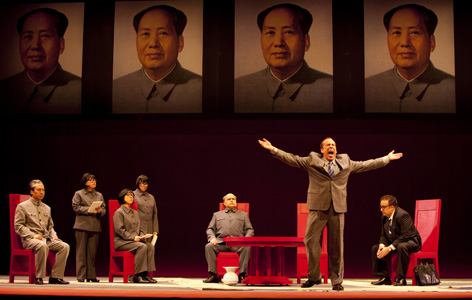June is typically a cold month in fog-bound San Francisco, but a series of events should brighten the days for those who appreciate opera, photography and golf.

Friday, June 8 is the long-awaited Bay Area premiere of Nixon in China by Pulitzer Prize-winning composer John Adams and librettist Alice Goodman.
By Paul Duclos
Published: June, 2012
June is typically a cold month in fog-bound San Francisco, but a series of events should brighten the days for those who appreciate opera, photography and golf.
San Francisco Opera’s summer 2012 season will feature three productions never before seen in San Francisco. Friday, June 8 is the long-awaited Bay Area premiere of Nixon in China by Pulitzer Prize-winning composer John Adams and librettist Alice Goodman. These performances mark the 25th anniversary of this work, originally co-commissioned by David Gockley.
The season continues with the San Francisco debut of a new co-production of Verdi’s Attila, opening June 12, which premiered at Milan’s Teatro alla Scala in June 2011 and features legendary Italian bass Ferruccio Furlanetto in the title role and Lucrecia Garcia in her Company debut as Odabella. Completing the Summer Season is Mozart’s The Magic Flute, beginning June 13, presented in a new production designed by visual artist Jun Kaneko and bringing together a strong ensemble cast including Heidi Stober, Alek Shrader, Nathan Gunn, Kristinn Sigmundsson and Albina Shagimuratova. http://sfopera.com/
The San Francisco Museum of Modern Art (SFMOMA), in cooperation with the Vatican Library, has announced the publication of a book on the previously unknown and major collection of photographs at the Vatican Library. Authored by SFMOMA’s Senior Curator of Photography Sandra S. Phillips, The Papal Collection of Photographs in the Vatican Library provides the first public look into this extraordinary collection. The book studies and reproduces over 100 photographs, and focuses on the period of the mid-19th to early 20th century, ending with pictures made around the time of World War II.
"This is a wonderful collection, one that was entirely unknown to the outside world," said Phillips. "It is extremely important not only for the pictures themselves—many beautiful examples of often unknown photographers, many of whom are not professionals—but also for their historical meaning, which is very significant."
The Vatican Library is among the oldest continuously operating libraries in the world. In the 19th century, after the medium was invented, photographs gradually entered the library’s holdings and were specifically directed to the Papal Addresses, a collection of items, mainly correspondence, sent to the Pope. Today this collection includes thousands of pictures. Many of the objects are not single photographs but are included in albums, portfolios, and other groupings, often in elaborate formats. The bindings and covers are sometimes intricately designed in semi-precious materials, though there are also many examples of simpler, more vernacular presentations. The collection has recently been relocated to the Department of Graphic Arts after the recent renovation of the library. http://www.sfmoma.org
The Olympic Club, San Francisco, hosts the next major PGA event from June 14 through 17. This is the fifth U.S. Open Championship and the 10th USGA championship to be conducted at the Olympic Club (Lake Course). Here are some highlights from the history of championship golf at the Olympic Club:
In 1955, Jack Fleck defeated four-time Open champion Ben Hogan in a playoff. Fleck, a municipal-course professional in Davenport, Iowa, who was playing his first full year on the tournament tour, birdied two of the last four holes to tie Hogan at seven-over-par 287. He shot 69 in the 18-hole playoff and never trailed, as Hogan carded a 73.
In 1966, Billy Casper won his second U.S. Open in a playoff with Arnold Palmer. Casper trailed by seven strokes with nine holes to play in the final round, but rallied to match Palmer at two-under-par 278. In the playoff, Palmer led by two shots after nine holes, but Casper erased the lead with a 50-foot birdie at the par-three 13th. Casper finished with a one-under-par 69, while Palmer shot 73.
Scott Simpson birdied the 14th, 15th and 16th holes of the final round in winning the 1987 U.S. Open and overtaking Tom Watson. Simpson’s 72-hole total of 277, three under par, was one stroke better than Watson’s 278. They were the only players to better par for the championship.
Lee Janzen made four birdies and no bogeys over the final 15 holes to capture his second U.S. Open in 1998 at the Olympic Club. Janzen, who finished at even-par 280 for a one-stroke win, came from seven strokes behind Payne Stewart, the largest come-from-behind victory after 54 holes in 25 years. He earned a share of the lead with birdies on the 12th and 13th holes, before carefully navigating pars the rest of the way. Stewart bogeyed the 16th, but had a chance to tie Janzen on the finishing hole. His 25-foot birdie putt slid inches below the hole. http://www.olyclub.com/

